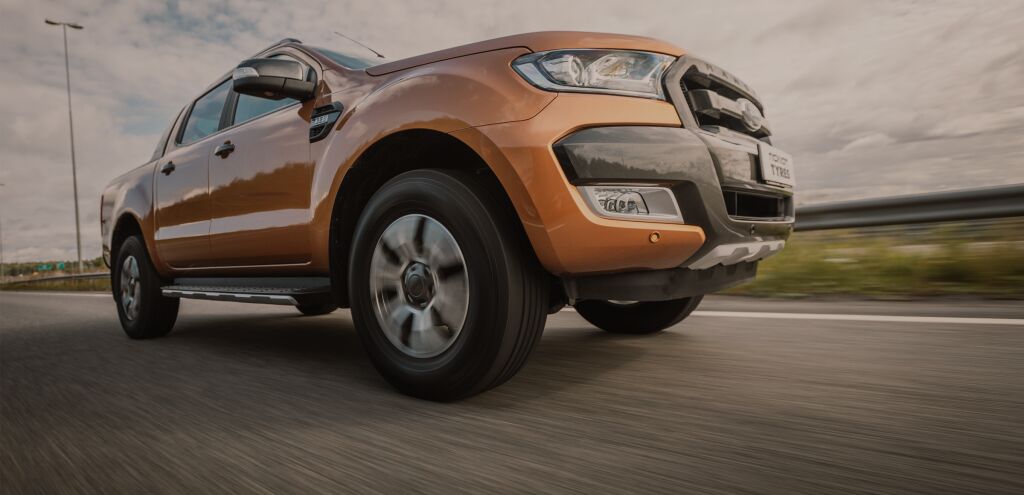
Tire tread depth directly impacts road safety and tire performance. Read how to check tread depth and what other factors you should consider.
Tire tread patterns – grooves and channels on the surface of tires – are designed to provide better performance in terms of traction and grip in different weather conditions. Tread depth refers to the vertical measurement of those grooves.
Tread depths have a direct impact on how your vehicle interacts with the road. The higher the tread depth is, the better control you have over your vehicle. Having a low tread depth can lead to road safety hazards, and may mean it’s time to replace your tires. It is important to check tread depth and tire wear regularly. If you read through this article and still have questions about your tire tread, contact your local tire dealer for peace of mind.
Why is tire tread important?
Having proper tire tread is essential for traction, stability, and control. High tread depth results in better braking performance. Tires grip the road more effectively, allowing shorter stopping times and better handling of the vehicle.
A worn tire tread causes road safety hazards, especially in challenging driving conditions. One of the functions of tire tread is to channel water, snow, and mud away, ensuring that they don’t accumulate between the tire and the road. This significantly reduced the risk of aquaplaning and loss of vehicle control. Simply put, higher tire tread depth translates to enhanced road safety.
What is a good tread depth?
When tread grooves are deep enough, they perform optimally and aid in a smooth driving experience. Usually, tire tread is measured in 0.8 mm. A minimum tread depth is 1.6 mm – after that tires are no longer safe to drive. Also, many countries legally require a minimum of 1.6 mm of tread depth. However, if approaching the lower limit of tread depth recommendation, tires have already lost much of their performance capabilities. That’s why we recommend considering replacing the tires when the tread depth is 3 mm. Nokian Tyres products have a driving safety indicator that helps you determine what level your tread depth is at.
It is particularly important to have good tread depth when driving in icy and snowy conditions. New Nokian Tyres winter tires have a tread depth of at least 8 mm. The recommended tread depth minimum is 4 mm.
Check your tire tread regularly
To keep driving safe, measure tire tread depth regularly. The best practice is to check tires at least once a month. A brief inspection can improve road safety, enhance the driving experience, and extend the tire life.
In addition to controlling tread depth, be attentive to tire wear. Tires may wear unevenly for various reasons, including incorrect tire pressure or alignments. Uneven wear can compromise the overall performance and safety of your vehicle.

How to check tire tread depth?
Nokian Tyres has made it easy to check tire tread depth. Each of the latest tires by Nokian Tyres has a driving safety indicator (DSI). This is a set of numbers (an indicator bar) that shows the tread remaining on the tires. You can simply check the indicator to see how deep the tire’s tread groove is.
You can also perform a tire tread test for a quick check of tread depth with the 2 € coin method:
- Take a 2 euro coin and push it into the tread groove.
- If you can see the silver rim, the tire is too worn and you should consider replacing the tires.
- Repeat the 2 euro coin test with all four tires of your vehicle.
If you are not sure how to perform the tread depth check correctly, seek assistance from a professional. In the car service centers, they can control tire tread with a tread depth gauge, giving an accurate result. You can call your local Nokian Tyres dealer to see if they offer these services.
When should you replace your tires?
Tires are the only contact point between the vehicle and the road, so it is extremely important to ensure their good condition. It is also important to be able to identify when to buy new tires. Consider replacing tires when the tread depth reaches 3 mm, and get new ones at the latest when the tread depth reaches 1,6 mm.
It might be time to replace tires if the tread wear is uneven, or if there are visible cracks on the tires. Also, the rubber compound of tires ages over time even without active use. You may want to replace tires older than six years.
Drive safe in all weather conditions
Correct tire tread depth helps to keep sure the tire performs properly. Check the tread depth regularly for enhanced road safety and better tire performance. You can help ensure your tires wear evenly and last longer with good maintenance, smooth driving, and proper tire storage. Once (or even before) you have reached the minimum safe tread depth level, replace your tires and drive safely in all weather conditions.
Please remember that it is the driver’s responsibility to ensure their tires are safe and suitable for their vehicle and to follow the vehicle’s manufacturer´s guidelines for proper use and maintenance. Consult your closest Nokian Tyres dealer or your vehicle’s manufacturer for specific advice.


